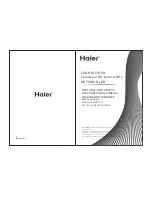
5
Repair facilities
7
5
Repair facilities
5.1
Functional blocks
On both the service printing on the copper and the component
side, functional blocks are indicated by lines and text.
5.1.1
Test points
The L6 chassis is equipped with test points in the service
printing on both sides of mono-board. These test points are
referring to the functional blocks as mentioned above:
•
P1-P2-P3, etc:Test points for the power supply
•
L1-L2-L3, etc:Test points for the line drive and line output
circuitry
•
F1-F2-F3, etc:Test points for the frame drive and frame
output circuitry
•
S1-S2-S3, etc:Test points for the synchronisation circuitry
•
V1-V2-V3, etc:Test points for the video processing circuitry
•
A1-A2-A3, etc:Test points for the audio processing circuitry
•
C1-C2-C3, etc:Test points for the control circuitry
•
T1-T2-T3, etc:Test points for the teletext processing
circuitry
The numbering is done in a for diagnostics logical sequence;
always start diagnosing within a functional block, in the
sequence of the relevant test points, for that functional block.
5.1.2
Service default-alignment mode (SDAM)
The service default-alignment mode is a pre-defined mode
which can be used for faultfinding (especially when the TV
gives no picture at all). All oscillograms and DC voltages in this
service manual are measured in the service default-alignment
mode.
Activating the service default-alignment mode can be done in 2
ways:
1.
By short-circuiting the service pins S1 and S2 of the
microcomputer (pin 14 of IC7600).
2.
From normal operation mode by pressing the button
"DEFAULT" or "ALIGN" on the DST (Dealer Service Tool)
RC7150.
Leaving the service default-alignment mode to normal
operation can only be done by the stand-by on the remote
control or by pressing diagnose 99 followed by the OK-button
on the DST (so not via mains switch "off"; after mains switch
"off" and then "on" again the set will start up in the service
default-alignment mode again to enable easy faultfinding).
Functions of the service default-alignment mode:
1.
All analogue settings (volume, contrast, brightness and
saturation) are in the mid position.
2.
Set is tuned to program number 1
3.
Delta volume settings are not used (delta volume setting =
a delta on the volume setting)
4.
OSD error message (present available error code) is
displayed continuously
5.
The OSD-key will act as search and auto store on the
maximum program number.
6.
Automatic switch off function (set switches "off" after 15
minutes no IDENT) will be switched off
7.
Hotel mode will be disabled
8.
All other functions remain normal controllable
Service default-alignment menu: new option settings are
activated immediately.
1.
Software version of the microprocessor used in that typical
set is displayed in the right top corner
2.
A counter in the middle of the screen indicate the normal
operation hours of the set in a hexadecimal code (every
time the set is switched "on" the counter is incremented by
1 hour, so +1 at the counter).
3.
The "S" in the middle of the screen next to the counter
indicate that the set is in the service default-alignment
mode
4.
Option codeThis code indicates the Options setting of the
set.
5.
Error code history;
The 5 last different error codes occurred are stored in the
EEPROM memory; last error code detected will be displayed
on the left side (see for an overview of all possible error codes
Fig. 8.x), so e.g.:
0 0 0 0 0 means no error codes present in the buffer
3 0 0 0 0 means one error code present in the buffer; error code
3
3 2 0 0 0 means two error codes present in the buffer; last
detected error code is error code 3, previous detected error
code is error code 2
The error code history buffer is cleared when the Service Menu
is left by the stand-by command or by diagnose 99 command.
In case the Service Menu is left by the mains switch "off" the
error code history buffer will not be cleared.
Option setting:
In the bottom line the options are given.
Control of the options is with the following keys on the remote
control:
•
P/-: Select the option to be changed; Via the
"P/-" button the option to be changed can be
selected. The selected option is implemented immediately.
•
CONTROL up/down: Changes the setting of the option.
•
MENU +/-: Changes to a submenu; via "MENU +/-" buttons
a submenu is selected in which in a stereo version the
sound/sync alignment can be done.
The options are stored immediately in the EEPROM.
The following table indicates the possible hardware and
software options and their technical consequences:
Option code +C "S" for
service menu
software version->
001
0023S
1.0
Error code history -->
23000
Option setting row -->
-
SYSTE
M BG + I
+
Text displayed in the option row in the service menu
The technical consequence for the selected option
SINGLE
--> For a PAL BG only or PAL BG/SECAM BGDK set
Содержание 286NS-05
Страница 14: ...10 Direction for use 28 Comet 10 Direction for use ...
Страница 15: ...10 Direction for use 29 Comet ...
Страница 16: ...10 Direction for use 30 Comet ...
Страница 17: ...10 Direction for use 31 Comet ...
Страница 18: ...10 Direction for use 32 Comet ...
Страница 19: ...10 Direction for use 33 Comet ...
Страница 20: ...10 Direction for use 34 Comet ...
Страница 25: ...6 Overview oscillograms 10 Comet ...
Страница 34: ...7 Electrical diagrams and print lay outs 19 Comet CL 86532029_008 eps 240698 ...








































